Need help understanding reverse voltage protection using a diode in Circuit Diagram
Need help understanding reverse voltage protection using a diode in Circuit Diagram each protection circuit are shown in Table 2. Use a circuit that is suitable for your application. V Table 2. Types of protection circuits and their advantage and disadvantage Reverse current prevention circuit TReverse current bypass circuit Circuit diagram DO IN UT C IN C T V IN V I E Figure 1 LDO IN OUT C IN C OUT V IN OUT I REVERSE Figure 2 A variety of circuits can provide this assurance. Diodes Provide the Simplest Protection. The simplest form of battery-reversal protection is a diode in series with the positive supply line (Figure 1a). The diode allows current from a correctly installed battery to flow to the load and blocks current flow to a backward-installed battery. Reverse Polarity Protection with a Schottky Diode. An easy way to mitigate both of the above disadvantages is to use a Schottky diode instead of a normal diode. This approach reduces voltage loss and power dissipation. I'm not sure how low Schottky diodes can go, but in some cases the forward voltage can be below 300 mV.

Figure 4. Reverse Current Prevention Using a Diode before the LDO Use a Second FET LDOs designed to block reverse current flow often use a second FET to help prevent reverse current flow. The two FETs are placed with the sources back to back, as shown in Figure 5 , so that the body diodes face each other. Now, when a reverse current condition

Defending Against Reverse Current: The Workings of Reverse Protection ... Circuit Diagram
Diodes Limitation to Reverse Current Protection. Using diode in series with a battery is easy and cheap remedy on reverse current protection. But, there is a downside to doing this. The heat generated in diode while protecting circuit from reverse current may be high enough to blow the diode. Power generated = V F x Current . The circuit below shows the improved design of using a protection diode in a circuit. To protect a component in a circuit, a diode is normally placed reverse biased in parallel with the component. When a diode is placed in parallel with the component you want protected reverse biasd, if current flows through the circuit in reverse, the current This electronics video tutorial explains how to protect your circuits from reverse polarity damage using diodes.What Is a Diode? h

Defending Against Reverse Current: The Workings of Reverse Protection Diodes Lgesemi: This guide offers a thorough examination of the vital role reverse protection diodes play in shielding electronic circuits from reverse current flow damage.It looks at how these diodes operate, how they're used in different systems, and what technological trends are influencing their advancement.
